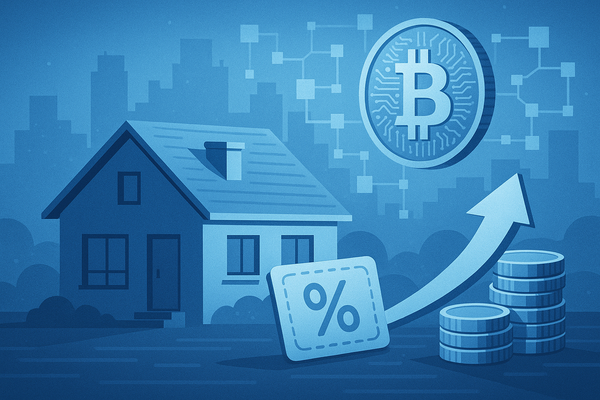Crypto ETFs and Tokenization: How Blockchain Is Transforming U.S. Equity Markets

The rise of cryptocurrency has rapidly moved from the fringes of finance into the very center of global capital markets. The launch of spot Bitcoin and Ethereum ETFs on U.S. exchanges such as the NYSE, Nasdaq, and CBOE has fundamentally changed how institutions, asset managers, and retail investors access digital assets. Once considered an alternative, crypto exposure is now a standard component of portfolio allocation, with many institutional funds dedicating double-digit percentages to the space. Options and structured products tied to these ETFs are expanding volumes and creating new fee streams, while the steady pipeline of altcoin ETF filings suggests this wave is only beginning.
This deepening integration is not happening in isolation. It is one of several forces, alongside advances in artificial intelligence, quantum computing, and renewed global capital flows, that are reinforcing the foundation of a secular bull market. Markets are repricing for a world being reshaped by new infrastructure and new forms of value creation.
SEC Regulation and Stablecoins: The Framework for Crypto and Equity Integration
Regulation, long the missing piece, is now catching up. The Securities and Exchange Commission’s Project Crypto initiative, alongside the Clarity Act, has given digital asset firms a clearer legal framework in which to operate. Stablecoin standards, reinforced by the Genius Act, have accelerated the use of USDC as a settlement and collateralization tool across both crypto-native and traditional markets.
Perhaps most strikingly, major corporations and even government agencies have begun to treat cryptocurrencies held on regulated exchanges as legitimate reserve assets, a development that would have been unthinkable only a few years ago.
Tokenized Stocks and Bonds: Blockchain’s Role in U.S. Equity Markets
Integration becomes most interesting when we look at mainstream equity venues. Asset managers such as BlackRock and Franklin Templeton are already pioneering tokenized money market funds, signaling a broader push to bring stocks and bonds onto blockchain rails. The tokenized treasury market has quickly reached $7 billion.
Tokenization offers real-time clearing and settlement, enhanced transparency, and substantial cost savings. With regulatory support, transfer agents and compliance functions are being built directly into smart contracts, slashing back-office costs and creating an entirely new model for capital market infrastructure.
Why Tokenized Shares Unlock Global Investors and 24/7 Trading
For issuers, the appeal is equally powerful. Tokenized shares open access to a global investor base, enable fractional ownership, and support round-the-clock trading. On OTC venues such as OTCQB and OTCQX, tokenized products are already democratizing access to cross-border capital and giving smaller companies new pathways to reach U.S. investors. What was once an innovation reserved for the largest firms is quickly becoming a tool for companies of every size.
What’s Next: Altcoin ETFs, Staking Products, and Tokenized Equities
The next wave is approaching quickly. Solana, Ripple, and other altcoins are expected to secure spot ETF and options approval, supported by custody infrastructure from industry leaders like Coinbase and Gemini. Staking-enabled ETFs for Ethereum are likely on the horizon, reshaping fund economics by integrating yield generation into standard operations.
At the same time, the SEC’s regulatory sandbox exemptions are paving the way for the tokenization of NYSE, Nasdaq, and OTC equities, opening the door to dual listings and direct blockchain-based settlement.
How Corporations and Exchanges Are Preparing for Tokenized Capital Markets
Corporate adoption is reinforcing these trends. Companies are increasingly holding crypto as part of their treasury reserves, erasing the boundaries between traditional and digital assets. As equity and debt instruments become tokenized, corporate treasurers will be operating in an environment of instant, global transfers—a profound change to capital management practices.
Market infrastructure is evolving in parallel, with standardization of cross-margining for crypto derivatives, deeper integration with prime brokerage workflows, and greater interoperability between legacy systems and blockchain-based platforms.
Challenges for Crypto and Tokenized Assets: Regulation, Custody, and Infrastructure
This transformation, however, will not come without risks. Fee compression for custodians and trading venues is inevitable as ETF volumes grow, pressuring business models and forcing innovation in derivatives and data services. Regulatory gray areas remain, particularly around compliance standards and custody rules for tokenized assets. The technical challenge of integrating back-end systems across exchanges, transfer agents, and blockchains will demand significant coordination and investment.
The Bullish Momentum Behind Crypto ETFs and Tokenization
Yet despite these hurdles, the momentum is unmistakable. Watch closely for imminent SEC decisions on new ETF categories, the launch of staking products, and the performance of newly public crypto firms such as Bullish and Gemini. As major asset managers like BlackRock, Franklin Templeton, and Bitmine continue to roll out tokenized products, and as OTC platforms adopt blockchain rails for wider dissemination and governance, the very architecture of U.S. capital markets is entering a period of historic change.
Crypto, Tokenization, and the Next Bull Market in Capital Formation
By late 2025 and into 2026, the line between crypto and equity markets will be increasingly difficult to draw. It will not just be about asset types, it will be about the underlying market infrastructure, accessibility, and regulatory oversight. Exchanges will evolve from simple trading venues into full-stack service providers bridging old and new financial systems. The result will be capital markets that operate 24/7 with instant settlement, real-time risk management, and truly global accessibility.
Taken together, this points to more than just incremental change. Crypto’s integration into equities and the broader tokenization of assets are structural drivers of the powerful bull market now underway. These innovations are expanding liquidity, lowering costs, and opening access to capital in ways that strengthen the foundation of long-term growth. As markets reprice for this future, investors are participating in the construction of a new, more expansive era for global capital formation.





